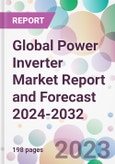According to the report, the global power inverter market is projected to grow at a substantial rate between 2024 and 2032. Aided by the increasing demands for energy-efficient power solutions and the rapid expansion of renewable energy, the market is expected to grow significantly by 2032.
Power inverters play a crucial role in modern energy systems by converting direct current (DC) to alternating current (AC), making them essential for both domestic and industrial applications. They are pivotal in renewable energy systems, particularly in solar and wind power generation, where they transform DC electricity produced by solar panels or turbines into usable AC power.
The global shift towards renewable energy sources, like solar and wind power, is a significant driver for the power inverter market growth, as these systems require efficient inverters for energy conversion. The automotive sector, especially in electric vehicles (EVs), increasingly relies on power inverters for efficient energy conversion, boosting market growth.
Technological advancements leading to higher efficiency, durability, and reduced costs of power inverters contribute to market expansion. The rising global energy consumption and electrification in developing countries fuel the demand for power inverters. The expansion of off-grid and hybrid renewable energy systems in remote areas offers significant growth prospects for the power inverter market.
Asia-Pacific leads the market, driven by rapid industrialisation, growing renewable energy installations, and increasing adoption of electric vehicles, particularly in China and India. North America and Europe also hold substantial market shares, attributed to their advanced technological infrastructure and strong focus on renewable energy.
As per the power inverter market analysis, the market is characterised by the presence of several leading players who are continuously innovating and expanding their product portfolios to cater to the diverse needs of the market. Strategic partnerships, mergers, acquisitions, and investments in research and development are common strategies employed by these players to maintain their market dominance.
Additionally, the market is poised for significant growth, driven by the ongoing global transition to renewable energy, technological advancements, and increasing applications in various sectors. The growing trend of smart inverters integrated with IoT technology for enhanced performance monitoring and management also contributes to the power inverter market size.
Power inverters play a crucial role in modern energy systems by converting direct current (DC) to alternating current (AC), making them essential for both domestic and industrial applications. They are pivotal in renewable energy systems, particularly in solar and wind power generation, where they transform DC electricity produced by solar panels or turbines into usable AC power.
The global shift towards renewable energy sources, like solar and wind power, is a significant driver for the power inverter market growth, as these systems require efficient inverters for energy conversion. The automotive sector, especially in electric vehicles (EVs), increasingly relies on power inverters for efficient energy conversion, boosting market growth.
Technological advancements leading to higher efficiency, durability, and reduced costs of power inverters contribute to market expansion. The rising global energy consumption and electrification in developing countries fuel the demand for power inverters. The expansion of off-grid and hybrid renewable energy systems in remote areas offers significant growth prospects for the power inverter market.
Asia-Pacific leads the market, driven by rapid industrialisation, growing renewable energy installations, and increasing adoption of electric vehicles, particularly in China and India. North America and Europe also hold substantial market shares, attributed to their advanced technological infrastructure and strong focus on renewable energy.
As per the power inverter market analysis, the market is characterised by the presence of several leading players who are continuously innovating and expanding their product portfolios to cater to the diverse needs of the market. Strategic partnerships, mergers, acquisitions, and investments in research and development are common strategies employed by these players to maintain their market dominance.
Additionally, the market is poised for significant growth, driven by the ongoing global transition to renewable energy, technological advancements, and increasing applications in various sectors. The growing trend of smart inverters integrated with IoT technology for enhanced performance monitoring and management also contributes to the power inverter market size.
Market Segmentation
The market can be divided based on rating, application, end use, and region.Market Breakup by Rating
- < 5KW
- 5KW to 100W
- 100KW to 500KW
- Above 500KW
Market Breakup by Application
- Motor Drives
- UPS
- Rail Traction
- Wind Turbines
- EVs/HEVs
- Solar PVs
- Others
Market Breakup by End Use
- Utilities
- Residential
- Commercial and Industrial
- Automotive and Transportation
Market Breakup by Region
- North America
- Europe
- Asia Pacific
- Latin America
- Middle East and Africa
Competitive Landscape
The report looks into the market shares, plant turnarounds, capacities, investments, and mergers and acquisitions, among other major developments, of the leading companies operating in the global power inverter market. Some of the major players explored in the report are as follows:- Huawei Technologies Co., Ltd.
- SMA Solar Technology AG
- Tabuchi Electric Co., Ltd.
- OMRON Corporation
- SolarEdge Technologies Inc.
- Others
Table of Contents
1 Preface2 Report Coverage - Key Segmentation and Scope4 Key Assumptions7 Opportunities and Challenges in the Market15 Value Chain Analysis16 Loans and Financial Assistance19 Key Trends and Developments in the Market
3 Report Description
5 Executive Summary
6 Snapshot
8 Global Power Inverter Market Analysis
9 North America Power Inverter Market Analysis
10 Europe Power Inverter Market Analysis
11 Asia Pacific Power Inverter Market Analysis
12 Latin America Power Inverter Market Analysis
13 Middle East and Africa Power Inverter Market Analysis
14 Market Dynamics
17 Project Economics
18 Competitive Landscape
List of Key Figures and Tables
Companies Mentioned
- Huawei Technologies Co. Ltd.
- SMA Solar Technology AG
- Tabuchi Electric Co.Ltd.
- OMRON Corporation
- SolarEdge Technologies Inc.
Methodology

LOADING...








